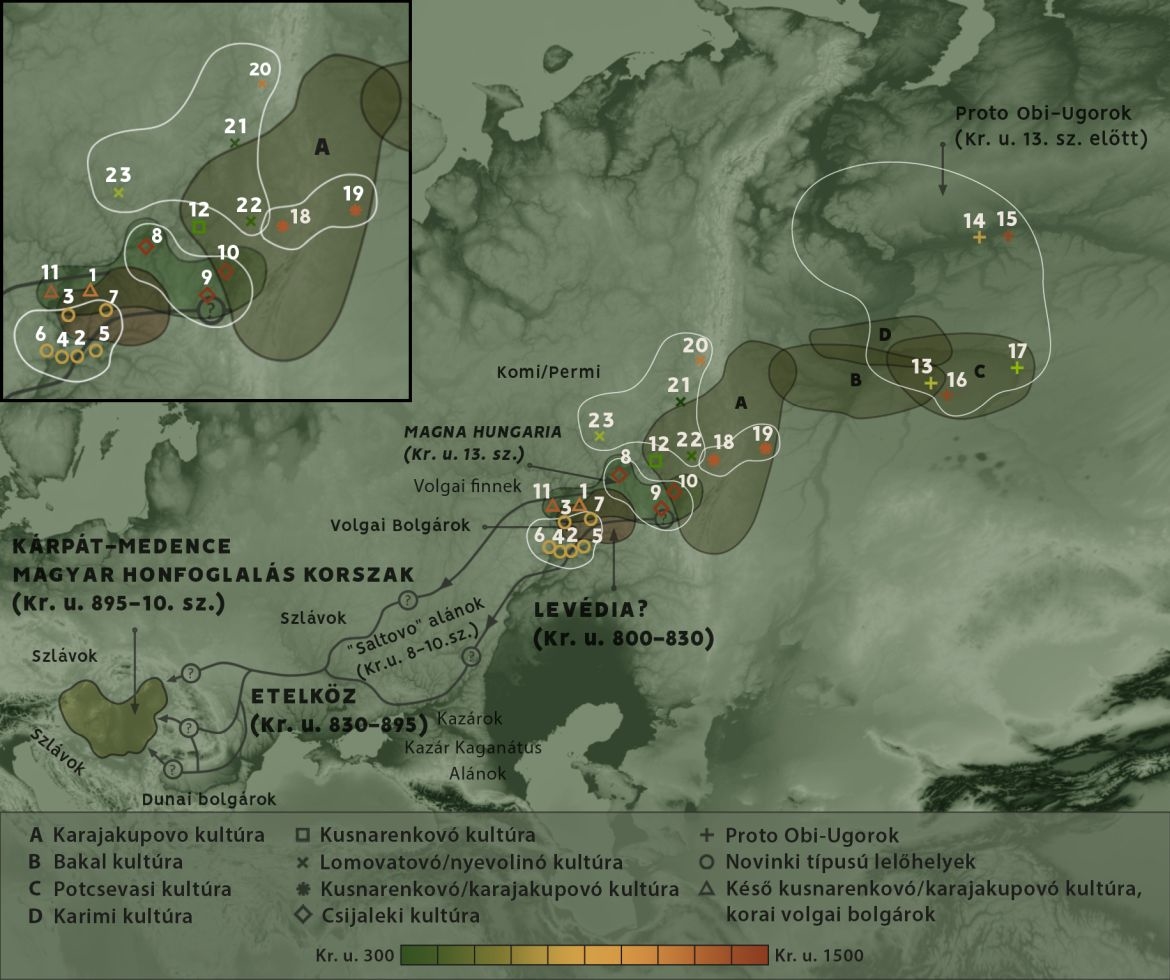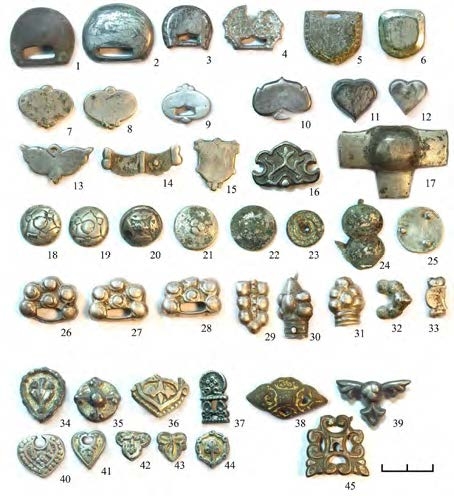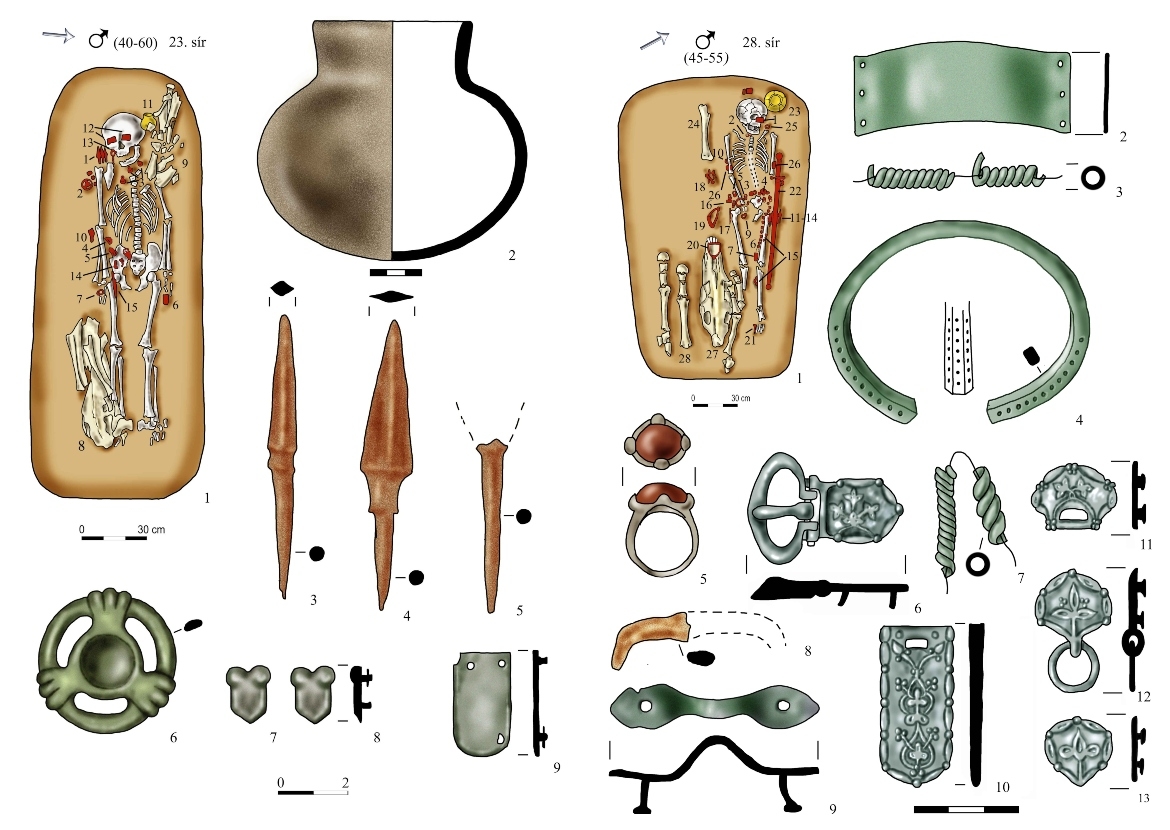As part of the most recent archaeogenetic research into Hungarian prehistory being conducted at the Institute of Archaeogenomics of the ELKH Research Centre for the Humanities (BTK), experts examined burial sites found along the presumed migration route of the Hungarians from various – archaeological, historical, and geographical – perspectives that could link them to these early Hungarians.
Based on these most recent results published by Oxford University Press in the scholarly journal Human Molecular Genetics, a number of clear genetic links can be identified between the early medieval groups connected to the Hungarians and representatives of the population of the conquerors of the Carpathian Basin.
This project dealing with the history of the population of early Hungarians was carried out in the framework of a collaborative scientific effort involving archaeologists, anthropologists and geneticists from a total of 18 institutions and universities. The researchers’ aim is to use the data to contribute to our understanding of the origins of the Hungarian people.
In the past decade, Péter Pázmány Catholic University and the ELKH BTK Hungarian Prehistoric Research Group have effectively collaborated on the excavation of Russian cemeteries linked to the early Hungarians and in the interpretation of the finds within the context of archaeological expeditions aimed at discovering sources. The collaborative research efforts provided the Hungarian team with the opportunity to take samples from the human bone material from the excavated cemeteries and to conduct archaeogenetic analyses on the samples. Continously emerging in connection with the formerly Hungarian-inhabited territories in the Volga and Ural regions, as defined on a linguistic-historical basis, were new archaeological points of connection whose biologically-based investigation was also joined by BTK’s Institute of Archaeogenomics.
The researchers’ aim was to contribute new data to the understanding of the origins of the Hungarian people. To this end, the working group examined the burial sites located on the presumed migration rout that could be linked to the early Hungarians from various – archaeological, historical and geographical – perspectives. The research also extended to characterizing the Hungarian population that remained in the Volga region in the 9th century, as well as the groups living in the immediate vicinity of areas inhabited by Hungarians. By comparing these results with the genetic data from the Carpathian Basin at the time of the conquest, the researchers searched to answer the question of the extent to which the genetic characteristics found in the Volga–Ural region were preserved among the conquering population.
It bears mentioning that the paper published in 2020 in the journal Scientific Reports, a part of the Nature publishing group, served as a direct precursor to this study. In this paper, Veronika Csáky, Dániel Gerber, and their co-authors confirmed for the first time the significance of the role of the early medieval Ural region in Hungarian ethnogenesis from a genetic point of view.
In the newly published study, Bea Szeifert, a scientific associate of the Institute of Archaeogenomics, and her co-authors, extending the work of two years ago, report on the archaeogenetic examination of the remains of 112 individuals from 18 early medieval grave sites in Russia, in the area between the Ob and Volga rivers.
 Territories inhabited by the early Hungarians and the presumed route of their migration (arrows). The sites that are the subject of archaeogenetic studies and the groups formed from them based on archaeological and chronological aspects (white outlines): Bolshie Tigani (1); Novinki group: Novinki (2), Mulovka (3), Brusyany (4), Lebyazhinka (5), Malaya Ryazan (6), Shilovka (7); Chiyalik group: Gulyukovo (8), Novo Hozyatovo (9), Gornovo (10); Tankeevka (11); Bustanaevo (12); Proto-Ob-Ugric group: Vikulovo (13), Barshov Gorodok (14), Ivanov Mis (15), Panovo (16), Ust-Tara (17); Uyelgi + Karanayevo group: Karanayevo (18), Uyelgi (19); Cis-Ural group: Bayanovo (20), Brody (21), Bartim (22), Sukhoy Log (23) (genetic examination of sites 19–23: Csáky et al, 2020)
Territories inhabited by the early Hungarians and the presumed route of their migration (arrows). The sites that are the subject of archaeogenetic studies and the groups formed from them based on archaeological and chronological aspects (white outlines): Bolshie Tigani (1); Novinki group: Novinki (2), Mulovka (3), Brusyany (4), Lebyazhinka (5), Malaya Ryazan (6), Shilovka (7); Chiyalik group: Gulyukovo (8), Novo Hozyatovo (9), Gornovo (10); Tankeevka (11); Bustanaevo (12); Proto-Ob-Ugric group: Vikulovo (13), Barshov Gorodok (14), Ivanov Mis (15), Panovo (16), Ust-Tara (17); Uyelgi + Karanayevo group: Karanayevo (18), Uyelgi (19); Cis-Ural group: Bayanovo (20), Brody (21), Bartim (22), Sukhoy Log (23) (genetic examination of sites 19–23: Csáky et al, 2020)
In the study, which offers a broader perspective, the researchers grouped the sites based on chronological and archaeological factors. Some of them belong to the period immediately after the ancestors of the Hungarians crossed the Ural Mountains (Kushnarenkovo culture), while other burial sites might have been used together by Hungarians and other ethnic groups of the Volga–Ural region (early Volga Bulgarians, Permian peoples) in the 9th-11th centuries. Still others may have been the burial sites of the Hungarians “left in the east” who were discovere by Friar Julian in the first half of the 13th century (Chiyalik culture, 11th-14th centuries). Two additional groups of sites that have now been examined are related to Hungarian ethnogenesis in the broader sense: the research performed on the 8-9 century Novinki-type burial sites along the Samara Bend of the Volga was justified by their geographical and chronological proximity to the Hungarians, as well as by their links to the Khazarian Khaganate, while the analysis of the finds from the early Obi-Ugric burial sites in Western Siberia was important due to the some 1,500-2,000 years of living side by side with each other after the linguistic separation from the Hungarians’ predecessors.
“During the analysis of mitochondrial DNA and Y-chromosomal lineages, we found many individual-level relationships between and within sites and site groups,” emphasized Bea Szeifert, the first author of the study.
 Belt mounts from the Karanayevo burial site belonging to the late Kushnarenkovo culture. (Photo: S. G. Botalov)
Belt mounts from the Karanayevo burial site belonging to the late Kushnarenkovo culture. (Photo: S. G. Botalov)
The examination of the burial sites of the Kushnarenkovo culture clearly provides a positive answer to a question that often arises: were the archaeological cultures formed by biologically related groups? Both the maternal and paternal lines of the human remains of the Uyelgi and Karanayevo cemeteries on both sides of the Urals indicate a close relationship with each other. Although significant parts of the populations of the two medieval burial sties can be traced back to the Iron Age roots of the southern Urals, the genetic composition of this earlier, local population had changed due to the effects of the passing time on the people living here.
These same biological and genetic relationships can also help in the identification of Julian-type Hungarians who were buried without material accoutrements. There are, in particular, many close maternal links that can be demonstrated between the burial sites from the 9th-10th century Bolshie Tigani (Image 2), which shows many parallels in terms of artifacts with the conquerors of the Carpathian Basin, and those attributed to Julian’s eastern Hungarians, which indicates at least partial continuity between the two communities.
As Attila Türk, assistant professor at PPKE BTK’s Department of Hungarian Prehistory and Conquest Period Archaeology, head of ELKH BTK’s Hungarian Prehistory Research Group, and the lead archaeologist of the study, emphasized, “This result clearly connects the burial sites of the Chiyalik culture, which in many cases due to the Islamization of the region are already poor in material accoutrements, with the Hungarians, which confirms the archaeological and historical hypothesis.”
 “Uralic” type graves from the Bolshie Tigani burial site
“Uralic” type graves from the Bolshie Tigani burial site
Most of the maternal and paternal lines identified in the Volga–Ural groups can also be found in the groups from the time of the Carpathian conquest. As a result of these recent investigations, some lineages reveal direct connections between the populations of the two regions, which indicate that their origins can be traced back to the Volga–Ural region, or at least to areas close to it.
The specialists carried out the reanalysis of the genetic data known from the burial sites from the era of the conquest of the Carpathian Basin according to a system based on the number of graves and the period of use of the burial sites developed by archaeologist László Kovács, a retired scientific advisor formerly with the BTK Institute of Archaeology. The greatest similarity with the studied population of the Volga–Ural region was exhibited by the 10th-century ethnic group that included the population of the so-called “inhabitation” cemeteries encompassing a small number of graves. In the case of the so-called village cemeteries in the Carpathian basin dating from the 10th-12th centuries and with a large number of graves, mixing with the local population becomes increasingly evident as time progresses. However, some of the maternal and paternal lines characteristic of the Volga–Ural region survived in these groups, often termed common people, too. The numerous maternal relationships described between the population of the two areas indicate that at the end of the 9th century, not only men, but entire families as well were arriving in the Carpathian basin.
The question arises whether the Eastern analogies of the archaeological findings from the Carpathian Basin are merely the results of trade relations or might indicate interactions between related populations. The authors of the study reported that a number of clear genetic links can be demonstrated between the representatives of the populations of the conquerors of the Carpathian Basin and the early medieval groups linked to the Hungarians – with the exception of the early Ob-Ugric people. All of this clearly proves that it is worthwhile examining Hungarian ethnogenesis along the lines of these archaeological analogies.
In the Volga–Ural region, it was possible to identify the previously described “eastern” elements in the population of the Carpathian Basin, which adds support from an archaeogenetic point of view as well to the historical, linguistic, and archaeological presumption that some of the conquerors of the Carpathian Basin came directly or indirectly from this region .
Anna Szécsényi-Nagy, head of BTK’s Institute of Archaeogenomics, added that, “In the future, the research will continue at the full genomic level, and we will also expand it in the direction of the former Etelköz homeland. Here, in addition to characterizing the Subbotsi-type sites linked to the Hungarians, we also place great emphasis on the comparative genetic analysis of their former neighbors, especially the Slavic-speaking peoples.”

